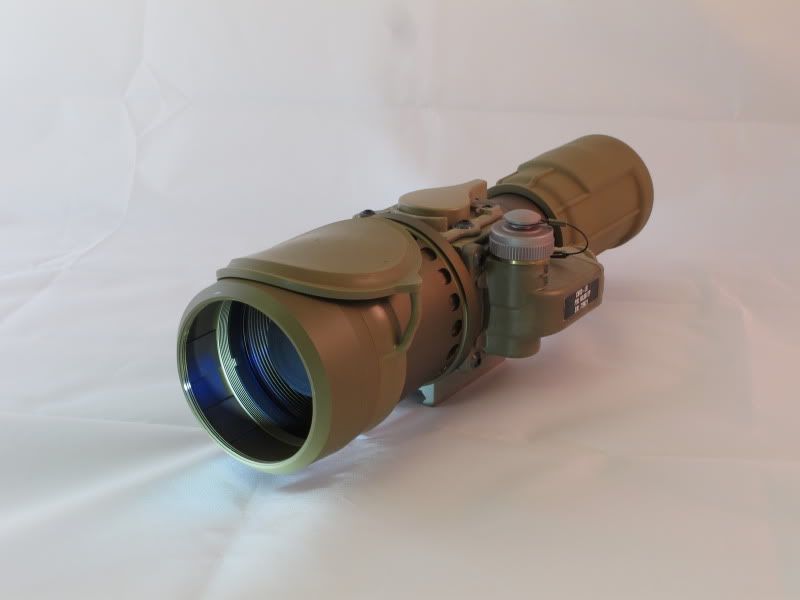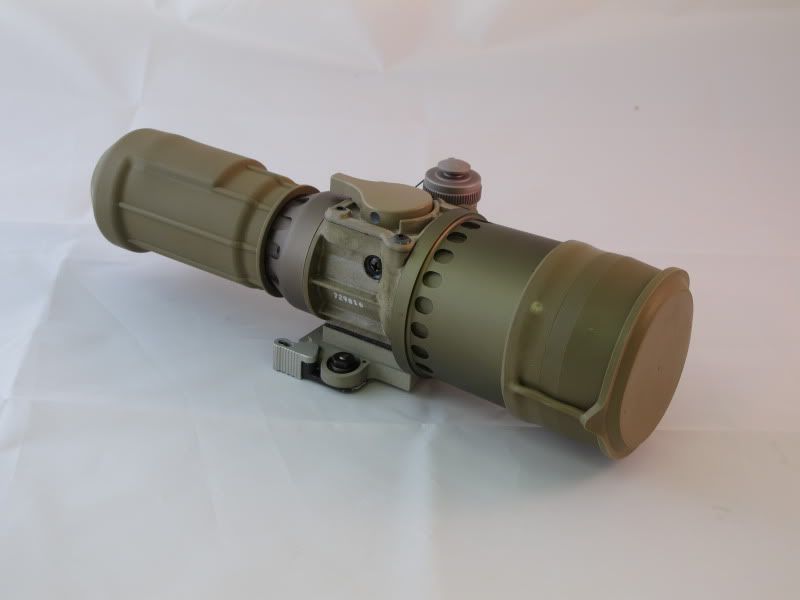As far as pure resolution at higher magnification goes the CNVD LR will outperform everything, the 26, the 27 and the 30 will not resolve as well as it does. It's a more powerful clip on in it's magnification and de-magnification. As such it can go high on the magnification scale of Day optics used with it.
Here is a repost from when the LR came out.
The CNVD LR has been out now for a bit and I have finally gotten around to writing it up.
The new unit shown here is the Latest in Clip on offering from L3 EOS Night Vision Systems. It is designed to be used an larger power scopes mainly on a Precision Rifle but it works well clear down to 4 power scopes to include the ACOGs. In fact I have never seen an ACOG look better at night.

Spec wise this new unit is ASTOUNDINGLY light at 1 Lb 13 ounces with a CR 123 installed. A note on the batteries. The CNVD series can take either a single AA battery (with an adapter) or a single CR 123 battery. Quite handy these days as you might run short of one or the other in the field. A discriminator senses if the battery is either an AA or a 123 and automatically adjusts to accept the incoming voltage. It mounts to a standard Mil 1913 Picatinny rail utilizing a, custom made for the application, LaRue Mount. The Finish is like the earlier PVS-24 done in a Flat Dark Earth Anodizing. I am quite partial to this color scheme. Living in a desert environment and having the unit already done up, means one less thing for me to have to paint.
As far as Recoil Resistance is concerned L3 is saying up to 338 but I have only run mine on .308. Now that .308 is a less than 7 lb FN bolt gun that kicks like a mule and no issues so far.
The Lens shade and Junction shroud are made of soft Rubber Ala the PVS 24s. The Lens shade is a bit on the skimpy side and is barely adequate to seal the objective off from incoming light. I will probably replace it with a Butler Creek cap if they make one large enough to fit the Lens shade. The Junction cover however is much better. It has a good bit of stretch that allows one to fit it over some fairly large objectives of Day optics if one wanted to use it. If you don't wish to use it, it stays out of the way quite nicely. I simply rolled mine back on it's self.
The unit mounts up pretty handily to most Precision Rifle platforms. A friend lent me his Remington mounted quite nicely in an AICS stock to check fit.
Now lets get to the Juicy stuff how does it LOOK??? Ok here are a series of Photos taken at 100 yards with a section of a Resolution Chart to show what the unit is capable of doing. Now the resolution chart is the great truth teller and this shows that the CNVD LR is a very good clip on. While the image quality appears fuzzy at the higher powers it is very good, Trust me on this one. This is the roughest optical test outside of a lab you can do with a clip on.
The Day Glass is a Night Force 5.5 to 22. Before this unit came out, I had said "I would be happy with it if it were clear at 10 power and usable at 12 power." Needles to say I was ready to do cartwheels when I first looked through it and ran it up to 15 power.
Here we have the image at 5.5 power.
Next we went up to about 8 power.
Next we went up to 10 power.
On up to 12 power.
Interesting at 15 power. I wasn't expecting this level of clarity.
Lastly at 22 power. A note here, the dimmer image is caused by the output of the day optic shrinking in Exit pupil as it goes up in power. 22 power is stretching the limits of ANY clip on. It isn't as noticeable when looking through the unit with your dark adjusted eye, but the camera did catch it and I was very surprised when I looked at the photos after the fact.
Let me recap, the CNVD LR is a light weight, easy to handle and focus piece of gear. It runs on either AA or 123 batteries, oh and did I mention LIGHT WEIGHT? If ya gotta hump a Night Vision Device any real distance, this is the unit for you.
LIGHT IS RIGHT ! ! !
Oh and one last thing to cover, the Objective lens in this thing has incredible depth of field which translates into MUCH LESS FOCUSING ! ! ! Even though the LR has retained the most excellent focusing lever from the PVS 24, you don't have to constantly futz with the focus on this unit unless you are looking at very different ranges rapidly. That, in and of itself is a HUGE plus in my book.
ETA
I got an email asking what tube is installed in these. They are an L3, Omega spec, Filmed, 11769 variable gain tube, same as in the PVS 14. A note here as well, the On /Off / Variable gain switch like the PVS 24, also comes on dim (tube brightness) and goes up in intensity as you crank it around. I find that I like this a great deal as I generally run anything with variable gain as dim as possible to try and keep my dominate eye closer in Night Vision Adaptation to the non aided eye. So it is nice to not have my Night Adapted vision blown out when the unit comes on.
Another thing I forgot to mention, bore sight alignment. Most people assume that if it is a clip on it is perfectly optically aligned and ya slap it on and no shift right?
Not so fast there gunslingers... or in this case precision Marksmen.
With all clip ons there is a set of specs on this. Usually it is 1 moa. In other words your night time zero should not be more than 1 moa off of your day zero. The hope is that it is (and to quote Marisa Tomme) "to be dead on balls accurate! it's an industry term."
The spec from L3 for bore sight alignment is .4 MOA or better which is probably the best going among clip ons. The "or better" part is very Important. As these systems first came out of L3, a group of folks were cross checking published repeatability, boresight alignment and other characteristics of the CNVD-LR. That field test information went back to L3 via one of the launch customers. Mod Armory and I2 Technologies (who are both Hide sponsor) as part of that group and we own some of the test equipment used to verify the CNVD-LR's performance in the real world.
A lot of that testing was comparing the LR to the PVS-27 and while this thread wasn't created to discuss that comparison we did note that with the proper equipment the LR can be re-bore sighted or have the tube swapped without having to go back to L3 in the event that your $9k+ piece of technology falls down a mountain or is otherwise damaged somehow. From speaking with OSTI your only option with the PVS-27 is to send it back to OSTI and a repair is a pretty in-depth process. This isn't a slam on the PVS-27, they designed it that way but that difference may at least be note worthy to a long range clip-on buyer.
ALL In ALL, this is my favorite clip on. Two thumbs Way, WAY up to L3 for this unit. I consider this some of the best money I have ever spent on any piece of equipment.












